Hydrogen Yield from the Partial Oxidation of Methane: Effect of Sc Promoter on Supported Ni/MCM-41 Catalyst
Abstract
:1. Introduction
2. Results and Discussion
2.1. N2 Physisorption
2.2. TPR Analysis
2.3. XRD Profile
2.4. FTIR Spectroscopy
2.5. XPS Analysis
2.6. Catalytic Activity Results
2.7. Raman Analysis
2.8. TGA Analysis
2.9. TEM Images
3. Materials and Method
3.1. Material
3.2. Catalyst Preparation
4. Conclusions
Supplementary Materials
Author Contributions
Funding
Data Availability Statement
Conflicts of Interest
References
- Kalinci, Y.; Hepbasli, A.; Dincer, I. Biomass-Based Hydrogen Production: A Review and Analysis. Int. J. Hydrogen Energy 2009, 34, 8799–8817. [Google Scholar] [CrossRef]
- Acar, C.; Dincer, I. Review and Evaluation of Hydrogen Production Options for Better Environment. J. Clean. Prod. 2019, 218, 835–849. [Google Scholar] [CrossRef]
- Fakeeha, A.H.; Vadodariya, D.M.; Alotibi, M.F.; Abu-Dahrieh, J.K.; Ibrahim, A.A.; Abasaeed, A.E.; Alarifi, N.; Kumar, R.; Al-Fatesh, A.S. Pd+Al2O3-Supported Ni-Co Bimetallic Catalyst for H2 Production through Dry Reforming of Methane: Effect of Carbon Deposition over Active Sites. Catalysts 2023, 13, 1374. [Google Scholar] [CrossRef]
- Yang, M.; Sun, Z.; Hu, Y.H. Novel WS2-Based 3D Electrode with Protecting Scaffold for Efficient and Stable Hydrogen Evolution. J. Phys. Chem. C 2019, 123, 12142–12148. [Google Scholar] [CrossRef]
- Sher, F.; Al-Shara, N.K.; Iqbal, S.Z.; Jahan, Z.; Chen, G.Z. Enhancing Hydrogen Production from Steam Electrolysis in Molten Hydroxides via Selection of Non-Precious Metal Electrodes. Int. J. Hydrogen Energy 2020, 45, 28260–28271. [Google Scholar] [CrossRef]
- Wang, Q.; Chen, X.; Jha, A.N.; Rogers, H. Natural Gas from Shale Formation—The Evolution, Evidences and Challenges of Shale Gas Revolution in United States. Renew. Sustain. Energy Rev. 2014, 30, 1–28. [Google Scholar] [CrossRef]
- Themelis, N.J.; Ulloa, P.A. Methane Generation in Landfills. Renew. Energy 2007, 32, 1243–1257. [Google Scholar] [CrossRef]
- Afarideh, M.; Esfanjani, P.; Sarlak, F.; Valipour, M.S. A Review on Solar Methane Reforming Systems for Hydrogen Production. Int. J. Hydrogen Energy 2024, in press. [Google Scholar] [CrossRef]
- Ganguli, A.; Bhatt, V. Hydrogen Production Using Advanced Reactors by Steam Methane Reforming: A Review. Front. Therm. Eng. 2023, 3, 1–15. [Google Scholar] [CrossRef]
- Wang, S.; Nabavi, S.A.; Clough, P.T. A Review on Bi/Polymetallic Catalysts for Steam Methane Reforming. Int. J. Hydrogen Energy 2023, 48, 15879–15893. [Google Scholar] [CrossRef]
- Massarweh, O.; Al-khuzaei, M.; Al-Shafi, M.; Bicer, Y.; Abushaikha, A.S. Blue Hydrogen Production from Natural Gas Reservoirs: A Review of Application and Feasibility. J. CO2 Util. 2023, 70, 102438. [Google Scholar] [CrossRef]
- Khaleel, A.; Jobe, S.; Ahmed, M.; Al-Zuhair, S.; Tariq, S. Enhanced Selectivity of Syngas in Partial Oxidation of Methane: A New Route for Promising Ni-Alumina Catalysts Derived from Ni/γ-AlOOH with Modified Ni Dispersion. Int. J. Energy Res. 2020, 44, 12081–12099. [Google Scholar] [CrossRef]
- Ma, L.; Ding, C.; Wang, J.; Xu, H.; Zhang, K. Lanthanide Modified Pt/CeO2-Based Catalysts for Methane Partial Oxidation: Relationship between Catalytic Activity and Structure. Int. J. Hydrogen Energy 2023, 48, 19074–19086. [Google Scholar] [CrossRef]
- Gazi, M.J.; Khurana, D.; Kaishyop, J.; Khan, T.S.; Bhandari, S.; Bordoloi, A. Solution Combustion Derived Nanoalloys: Robust and Efficient Catalyst Systems for Partial Oxidation of Methane. Int. J. Hydrogen Energy 2024, 51, 562–579. [Google Scholar] [CrossRef]
- Al-anazi, A.; Bellahwel, O.; Kavitha, C.; Abu-dahrieh, J.; Ibrahim, A.A.; Santhosh, S.; Abasaeed, A.E.; Fakeeha, A.H.; Al-fatesh, A.S. Promoter Impact on 4Ni/SAPO-5 Catalyst for H2 Production via Methane Partial Oxidation. Catalysts 2024, 14, 316. [Google Scholar] [CrossRef]
- Zeng, H.; Wang, Y.; Gong, S.; Shi, Y.; Cai, N. Catalytically Enhanced Methane-Rich Combustion by Porous Media Reactor. Fuel 2019, 248, 65–75. [Google Scholar] [CrossRef]
- Shi, S.; Sun, Z.; Bao, C.; Gao, T.; Hu, Y.H. The Special Route toward Conversion of Methane to Methanol on a Fluffy Metal-Free Carbon Nitride Photocatalyst in the Presence of H2O2. Int. J. Energy Res. 2020, 44, 2740–2753. [Google Scholar] [CrossRef]
- Jin, Z.; Wang, L.; Zuidema, E.; Mondal, K.; Zhang, M.; Zhang, J.; Wang, C.; Meng, X.; Yang, H.; Mesters, C.; et al. Hydrophobic Zeolite Modification for In Situ Peroxide Formation in Methane Oxidation to Methanol. Science 2020, 367, 193–197. [Google Scholar] [CrossRef]
- Jung, S.; Lee, J.; Moon, D.H.; Kim, K.H.; Kwon, E.E. Upgrading Biogas into Syngas through Dry Reforming. Renew. Sustain. Energy Rev. 2021, 143, 110949. [Google Scholar] [CrossRef]
- Galadima, A.; Muraza, O. From Synthesis Gas Production to Methanol Synthesis and Potential Upgrade to Gasoline Range Hydrocarbons: A Review. J. Nat. Gas Sci. Eng. 2015, 25, 303–316. [Google Scholar] [CrossRef]
- Ibrahim, A.A.; Fakeeha, A.H.; Abasaeed, A.E.; Wazeer, I.; Bentalib, A.; Siva Kumar, N.; Abu-Dahrieh, J.K.; Al-Fatesh, A.S. The Effectiveness of Ni-Based Bimetallic Catalysts Supported by MgO-Modified Alumina in Dry Methane Reforming. Catalysts 2023, 13, 1420. [Google Scholar] [CrossRef]
- Angeli, S.D.; Turchetti, L.; Monteleone, G.; Lemonidou, A.A. Catalyst Development for Steam Reforming of Methane and Model Biogas at Low Temperature. Appl. Catal. B Environ. 2016, 181, 34–46. [Google Scholar] [CrossRef]
- Chien, A.C.; Ye, N.J. Effect of Preparation Method and Particle Size of Ni/SDC Catalyst on Methane Oxidation. Catal. Commun. 2021, 154, 106312. [Google Scholar] [CrossRef]
- Pakhare, D.; Spivey, J. A Review of Dry (CO2) Reforming of Methane over Noble Metal Catalysts. Chem. Soc. Rev. 2014, 43, 7813–7837. [Google Scholar]
- Niu, J.; Du, X.; Ran, J.; Wang, R. Dry (CO2) Reforming of Methane over Pt Catalysts Studied by DFT and Kinetic Modeling. Appl. Surf. Sci. 2016, 376, 79–90. [Google Scholar] [CrossRef]
- Wang, N.; Shen, K.; Yu, X.; Qian, W.; Chu, W. Preparation and Characterization of a Plasma Treated NiMgSBA-15 Catalyst for Methane Reforming with CO2 to Produce Syngas. Catal. Sci. Technol. 2013, 3, 2278–2287. [Google Scholar] [CrossRef]
- Liu, C.J.; Ye, J.; Jiang, J.; Pan, Y. Progresses in the Preparation of Coke Resistant Ni-Based Catalyst for Steam and CO2 Reforming of Methane. ChemCatChem 2011, 3, 529–541. [Google Scholar]
- Chien, A.C.; Liao, B.Y.; Chen, W.Y.; Chien, A.C. Studies of Exsolution and Catalytic Activity of Metal Nanocatalysts from Parent Perovskite. Catal. Sci. Technol. 2021, 11, 4570–4580. [Google Scholar] [CrossRef]
- Bradford, M.C.J.; Vannice, M.A. The Role of Metal-Support Interactions in CO2 Reforming of CH4. Catal. Today 1999, 50, 87–96. [Google Scholar] [CrossRef]
- Tang, M.; Liu, K.; Roddick, D.M.; Fan, M. Enhanced Lattice Oxygen Reactivity over Fe2O3/Al2O3 Redox Catalyst for Chemical-Looping Dry (CO2) Reforming of CH4: Synergistic La-Ce Effect. J. Catal. 2018, 368, 38–52. [Google Scholar] [CrossRef]
- Faria, E.C.; Neto, R.C.R.; Colman, R.C.; Noronha, F.B. Hydrogen Production through CO2 Reforming of Methane over Ni/CeZrO2/Al2O3 Catalysts. In Catalysis Today; Elsevier: Amsterdam, The Netherlands, 2014; pp. 138–144. [Google Scholar]
- Stagg-Williams, S.M.; Noronha, F.B.; Fendley, G.; Resasco, D.E. CO2 Reforming of CH4 over Pt/ZrO2 Catalysts Promoted with La and Ce Oxides. J. Catal. 2000, 194, 240–249. [Google Scholar] [CrossRef]
- Hasnan, N.S.N.; Timmiati, S.N.; Lim, K.L.; Yaakob, Z.; Kamaruddin, N.H.N.; Teh, L.P. Recent Developments in Methane Decomposition over Heterogeneous Catalysts: An Overview. Mater. Renew. Sustain. Energy 2020, 9, 8. [Google Scholar] [CrossRef]
- Sun, X.; Xu, D.; Dai, P.; Liu, X.; Tan, F.; Guo, Q. Efficient Degradation of Methyl Orange in Water via Both Radical and Non-Radical Pathways Using Fe-Co Bimetal-Doped MCM-41 as Peroxymonosulfate Activator. Chem. Eng. J. 2020, 402, 125881. [Google Scholar] [CrossRef]
- Kumar, N.; Leino, E.; Mäki-Arvela, P.; Aho, A.; Käldström, M.; Tuominen, M.; Laukkanen, P.; Eränen, K.; Mikkola, J.P.; Salmi, T.; et al. Synthesis and Characterization of Solid Base Mesoporous and Microporous Catalysts: Influence of the Support, Structure, and Type of Base Metal. Microporous Mesoporous Mater. 2012, 152, 71–77. [Google Scholar] [CrossRef]
- Dündar-Tekkaya, E.; Yürüm, Y. Effect of Loading Bimetallic Mixture of Ni and Pd on Hydrogen Storage Capacity of MCM-41. Int. J. Hydrogen Energy 2015, 40, 7636–7643. [Google Scholar] [CrossRef]
- Li, M.; Hui, K.N.; Hui, K.S.; Lee, S.K.; Cho, Y.R.; Lee, H.; Zhou, W.; Cho, S.; Chao, C.Y.H.; Li, Y. Influence of Modification Method and Transition Metal Type on the Physicochemical Properties of MCM-41 Catalysts and Their Performances in the Catalytic Ozonation of Toluene. Appl. Catal. B Environ. 2011, 107, 245–252. [Google Scholar] [CrossRef]
- Pârvulescu, V.; Anastasescu, C.; Su, B.L. Bimetallic Ru-(Cr, Ni, or Cu) and La-(Co or Mn) Incorporated MCM-41 Molecular Sieves as Catalysts for Oxidation of Aromatic Hydrocarbons. J. Mol. Catal. A Chem. 2004, 211, 143–148. [Google Scholar] [CrossRef]
- Wang, Z.; Wang, L.; Cui, Y.; Xing, Y.; Su, W. Research on Nickel-Based Catalysts for Carbon Dioxide Methanation Combined with Literature Measurement. J. CO2 Util. 2022, 63, 102117. [Google Scholar] [CrossRef]
- Chien, A.C.; Ye, N.J.; Huang, C.W.; Tseng, I.H. Studies of Nickel/Samarium-Doped Ceria for Catalytic Partial Oxidation of Methane and Effect of Oxygen Vacancy. Catalysts 2021, 11, 731. [Google Scholar] [CrossRef]
- Shiratori, Y.; Teraoka, Y.; Sasaki, K. Ni1-x-YMgxAlyO-ScSZ Anodes for Solid Oxide Fuel Cells. Solid State Ion. 2006, 177, 1371–1380. [Google Scholar] [CrossRef]
- Rajput, Y.B.; Al-Fatesh, A.S.; Osman, A.I.; Bayazed, M.O.; Ibrahim, A.A.; Fakeeha, A.H.; Abasaeed, A.E.; Almubaddel, F.S.; Alothman, O.; Kumar, R. Enhancing Hydrogen Production via Dry Reforming of Methane: Optimization of Co and Ni on Scandia-Ceria-Zirconia Supports for Catalytic Efficiency and Economic Feasibility. Fuel 2024, 378, 132843. [Google Scholar] [CrossRef]
- Reza Loghman-Estarki, M.; Shoja Razavi, R.; Edris, H. Synthesis of Scandia, Yttria Stabilized Zirconia (SYSZ) Nanoparticles by New Wet Chemistry Method. Curr. Nanosci. 2012, 8, 767–775. [Google Scholar] [CrossRef]
- Al-Fatesh, A.S.; Atia, H.; Abu-Dahrieh, J.K.; Ibrahim, A.A.; Eckelt, R.; Armbruster, U.; Abasaeed, A.E.; Fakeeha, A.H. Hydrogen Production from CH4 Dry Reforming over Sc Promoted Ni / MCM-41. Int. J. Hydrogen Energy 2019, 44, 20770–20781. [Google Scholar] [CrossRef]
- Xu, L.; Zhang, J.; Ding, J.; Liu, T.; Shi, G.; Li, X.; Dang, W.; Cheng, Y.; Guo, R. Pore Structure and Fractal Characteristics of Different Shale Lithofacies in the Dalong Formation in the Western Area of the Lower Yangtze Platform. Minerals 2020, 10, 72. [Google Scholar] [CrossRef]
- Tang, Z.; Zhang, Y.; Guo, Q. Catalytic Hydrocracking of Pyrolytic Lignin to Liquid Fuel in Supercritical Ethanol. Ind. Eng. Chem. Res. 2010, 49, 2040–2046. [Google Scholar] [CrossRef]
- Cho, Y.S.; Park, J.C.; Lee, B.; Kim, Y.; Yi, J. Preparation of Mesoporous Catalyst Supported on Silica with Finely Dispersed Ni Particles. Catal. Lett. 2002, 81, 89–96. [Google Scholar] [CrossRef]
- Schreifels, J.A.; Maybury, P.C.; Swartz, W.E. X-Ray Photoelectron Spectroscopy of Nickel Boride Catalysts: Correlation of Surface States with Reaction Products in the Hydrogenation of Acrylonitrile. J. Catal. 1980, 65, 195–206. [Google Scholar] [CrossRef]
- Lian, K.K.; Kirk, D.W.; Thorpe, S.J. Erratum: Investigation of a “Two-State” Tafel Phenomenon for the Oxygen Evolution Reaction on an Amorphous Ni-Co Alloy. Electrochem. Soc. 1995, 142, 4309. [Google Scholar] [CrossRef]
- Bianchi, C.L.; Cattania, M.G.; Villa, P. XPS Characterization of Ni and Mo Oxides before and after “in Situ” Treatments. Appl. Surf. Sci. 1993, 70, 211–216. [Google Scholar] [CrossRef]
- Mansour, A.N. Characterization of β -Ni (OH)2 by XPS. Surf. Sci. Spectra 1994, 3, 239–246. [Google Scholar] [CrossRef]
- Gimzewski, J.K.; Fabian, D.J.; Watson, L.M.; Affrossman, S. X-Ray Photoelectron Studies of Scandium and Its Hydride and Oxide. J. Phys. F Met. Phys. 1977, 7, L305. [Google Scholar] [CrossRef]
- Myers, C.E.; Franzen, H.F.; Anderegg, J.W. X-ray photoelectron spectra and bonding in transition-metal phosphides. Inorg. Chem. 1985, 24, 1822–1824. [Google Scholar] [CrossRef]
- Al-Fatesh, A.S.; Kasim, S.O.; Ibrahim, A.A.; Osman, A.I.; Abasaeed, A.E.; Atia, H.; Armbruster, U.; Frusteri, L.; Bin Jumah, A.; Mohammed Alanazi, Y.; et al. Greenhouse Gases Utilization via Catalytic Reforming with Sc Promoted Ni/SBA-15. Fuel 2022, 330, 125523. [Google Scholar] [CrossRef]
- Takigawa, Y.; Kurosawa, K.; Sasaki, W.; Yoshida, K.; Fujiwara, E.; Kato, Y. SiO Bond Breaking in SiO2 by Vacuum Ultraviolet Laser Radiation. J. Non-Cryst. Solids 1990, 116, 293–296. [Google Scholar] [CrossRef]
- Al-Fatesh, A.S.; Arafat, Y.; Kasim, S.O.; Ibrahim, A.A.; Abasaeed, A.E.; Fakeeha, A.H. In Situ Auto-Gasification of Coke Deposits over a Novel Ni-Ce/W-Zr Catalyst by Sequential Generation of Oxygen Vacancies for Remarkably Stable Syngas Production via CO2-Reforming of Methane. Appl. Catal. B Environ. 2021, 280, 119445. [Google Scholar] [CrossRef]
- Damaskinos, C.M.; Vasiliades, M.A.; Efstathiou, A.M. The Effect of Ti4+ Dopant in the 5 Wt% Ni/Ce1-XTixO2-Δ Catalyst on the Carbon Pathways of Dry Reforming of Methane Studied by Various Transient and Isotopic Techniques. Appl. Catal. A Gen. 2019, 579, 116–129. [Google Scholar] [CrossRef]
- Du, G.; Lim, S.; Yang, Y.; Wang, C.; Pfefferle, L.; Haller, G.L. Catalytic Performance of Vanadium Incorporated MCM-41 Catalysts for the Partial Oxidation of Methane to Formaldehyde. Appl. Catal. A Gen. 2006, 302, 48–61. [Google Scholar] [CrossRef]
- Ding, C.; Wang, J.; Li, Y.; Ma, Q.; Ma, L.; Guo, J.; Ma, Z.; Liu, P.; Zhang, K. The Role of Active Sites Location in Partial Oxidation of Methane to Syngas for MCM-41 Supported Ni Nanoparticles. Catalysts 2019, 9, 606. [Google Scholar] [CrossRef]
- Liu, R.; Yang, M.; Huang, C.; Weng, W.; Wan, H. Partial Oxidation of Methane to Syngas over Mesoporous Co-Al2O3 Catalysts. Chin. J. Catal. 2013, 34, 146–151. [Google Scholar] [CrossRef]
- Moral, A.; Reyero, I.; Llorca, J.; Bimbela, F.; Gandía, L.M. Partial Oxidation of Methane to Syngas Using Co/Mg and Co/Mg-Al Oxide Supported Catalysts. Catal. Today 2019, 333, 259–267. [Google Scholar] [CrossRef]
- Lucrédio, A.F.; Jerkiewicz, G.; Assaf, E.M. Cobalt Catalysts Promoted with Cerium and Lanthanum Applied to Partial Oxidation of Methane Reactions. Appl. Catal. B Environ. 2008, 84, 106–111. [Google Scholar] [CrossRef]
- Fakeeha, A.H.; Arafat, Y.; Ibrahim, A.A.; Shaikh, H.; Atia, H.; Abasaeed, A.E.; Armbruster, U.; Al-Fatesh, A.S. Highly Selective Syngas/H2 Production via Partial Oxidation of CH4 Using (Ni, Co and Ni-Co)/ZrO2-Al2O3 Catalysts: Influence of Calcination Temperature. Processes 2019, 7, 141. [Google Scholar] [CrossRef]
- Xia, W.S.; Hou, Y.H.; Chang, G.; Weng, W.Z.; Han, G.-B.; Wan, H.-L. Partial Oxidation of Methane into Syngas (H2 + CO) over Effective High-Dispersed Ni/SiO2 Catalysts Synthesized by a Sol–Gel Method. Int. J. Hydrogen Energy 2012, 37, 8343–8353. [Google Scholar] [CrossRef]
- Emamdoust, A.; La Parola, V.; Pantaleo, G.; Testa, M.L.; Farjami Shayesteh, S.; Venezia, A.M. Partial Oxidation of Methane over SiO2 Supported Ni and NiCe Catalysts. J. Energy Chem. 2020, 47, 1–9. [Google Scholar] [CrossRef]
- Wang, X.; Wang, Y.; Tang, Q.; Guo, Q.; Zhang, Q.; Wan, H. MCM-41-Supported Iron Phosphate Catalyst for Partial Oxidation of Methane to Oxygenates with Oxygen and Nitrous Oxide. J. Catal. 2003, 217, 457–467. [Google Scholar] [CrossRef]
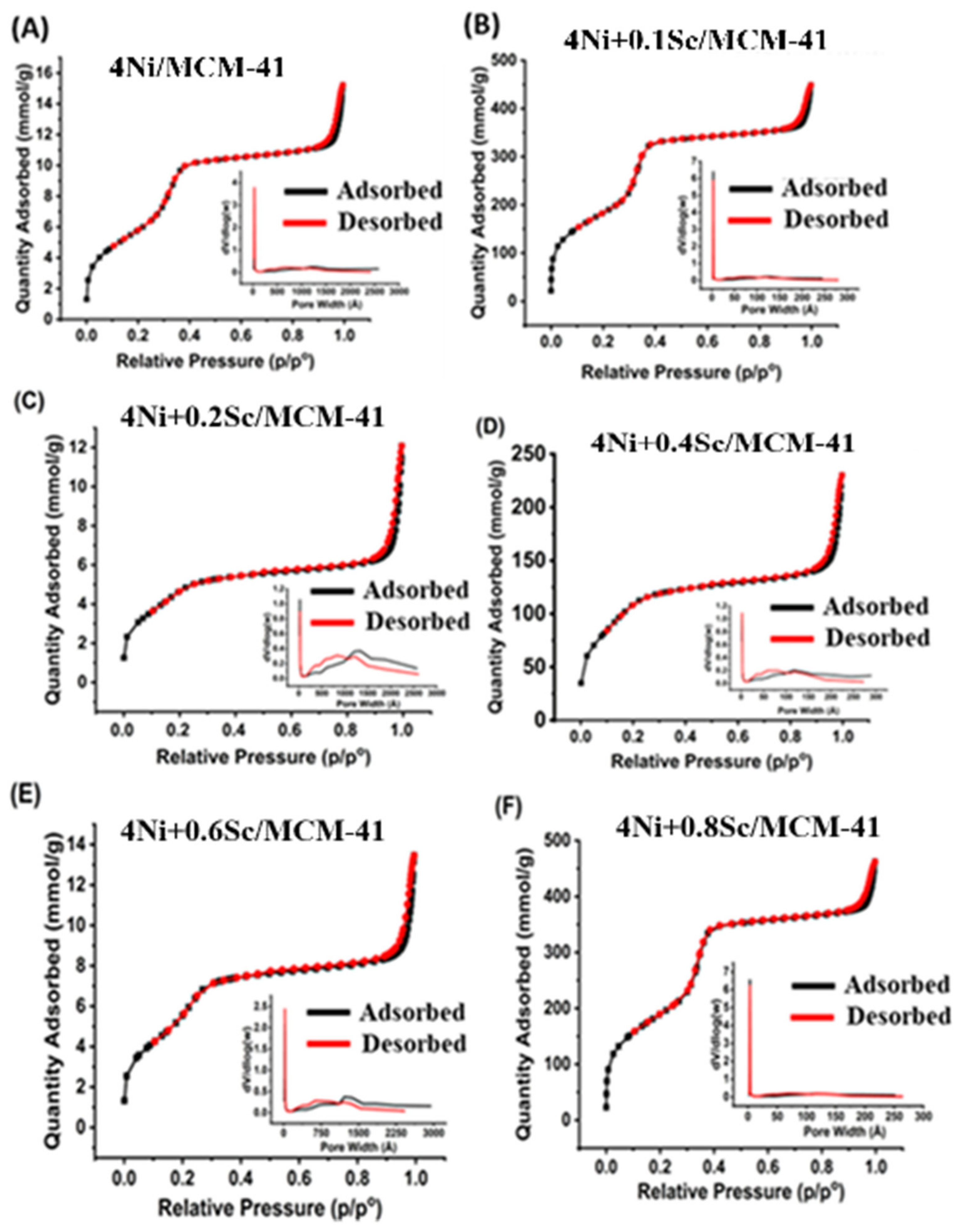

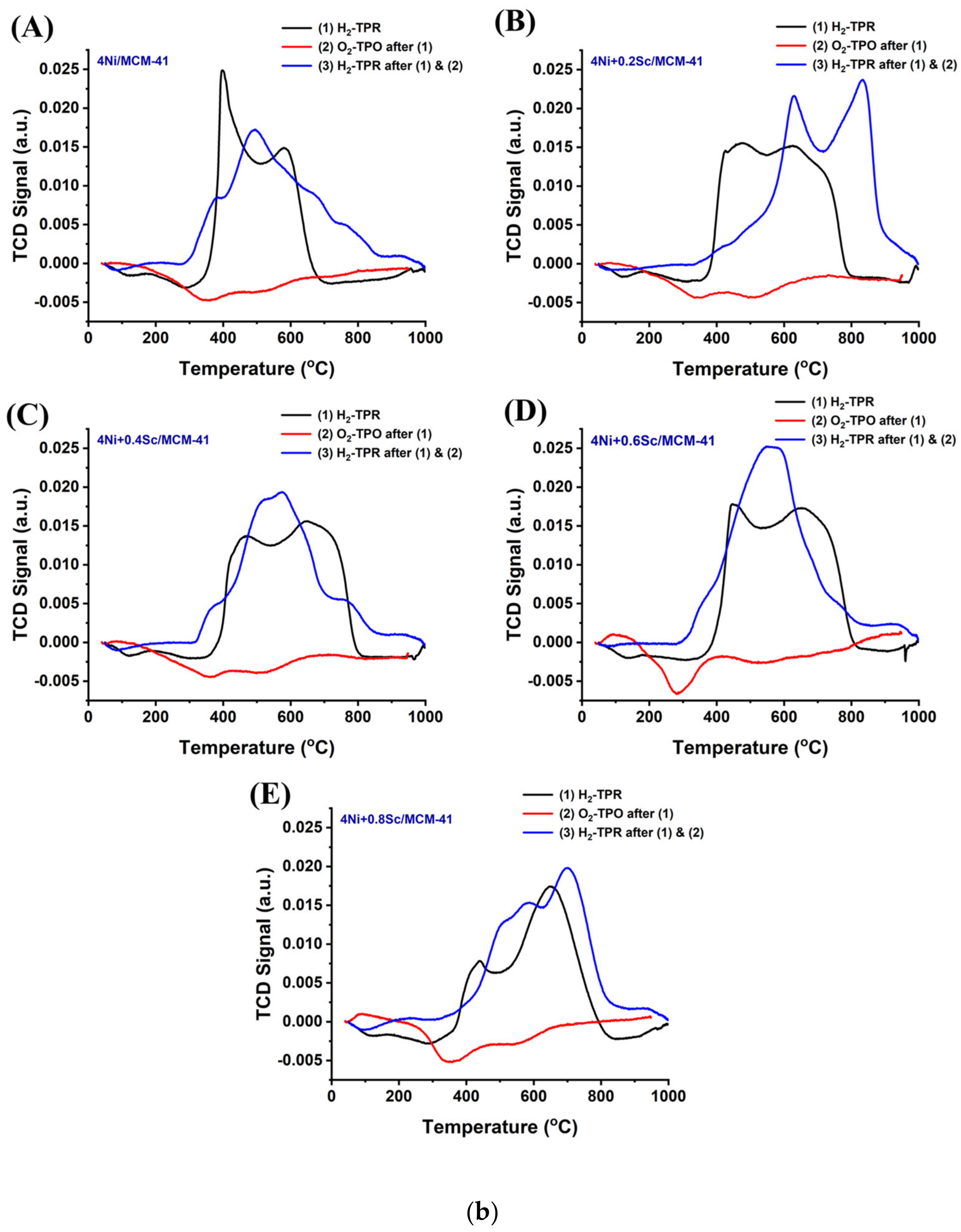
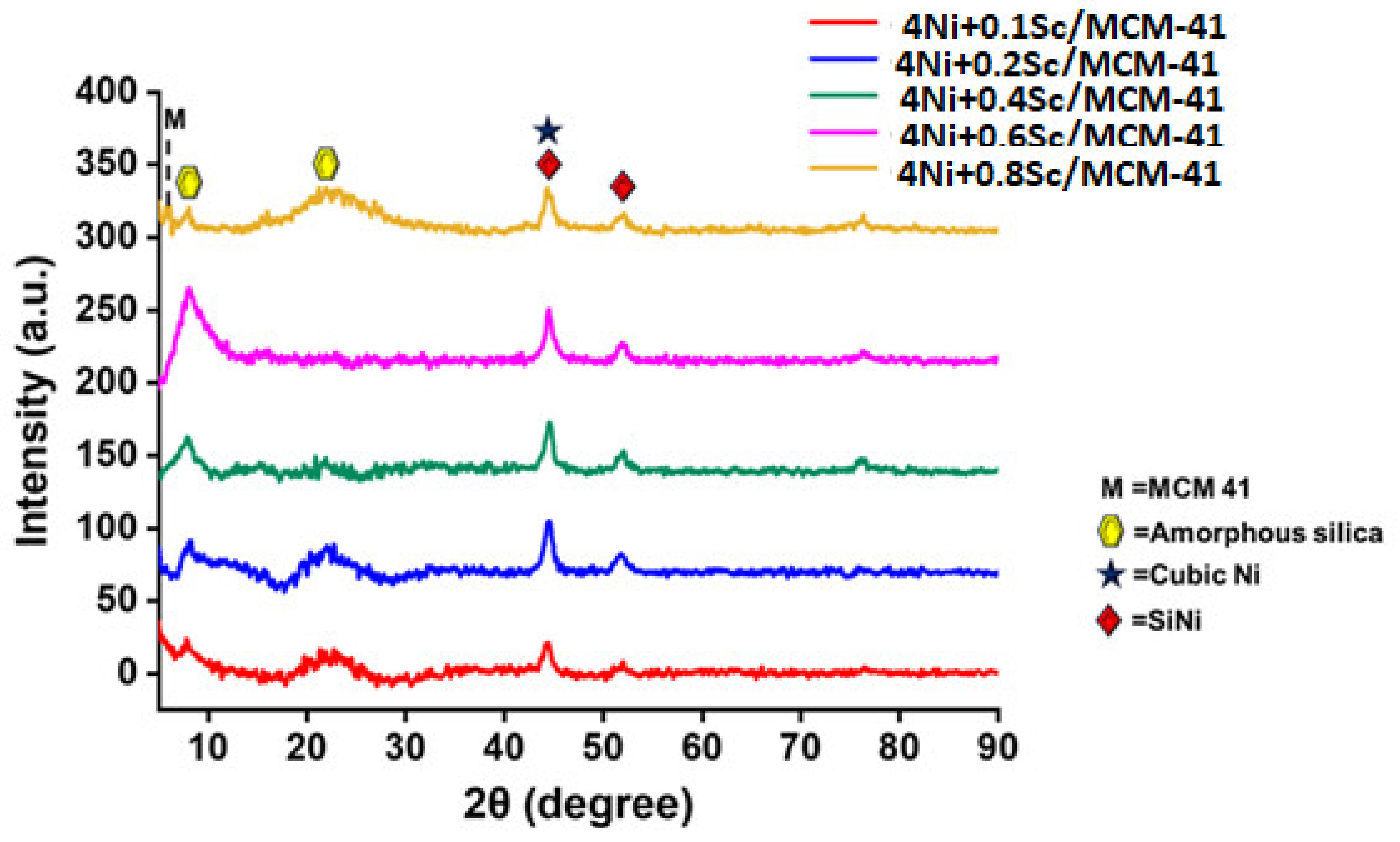
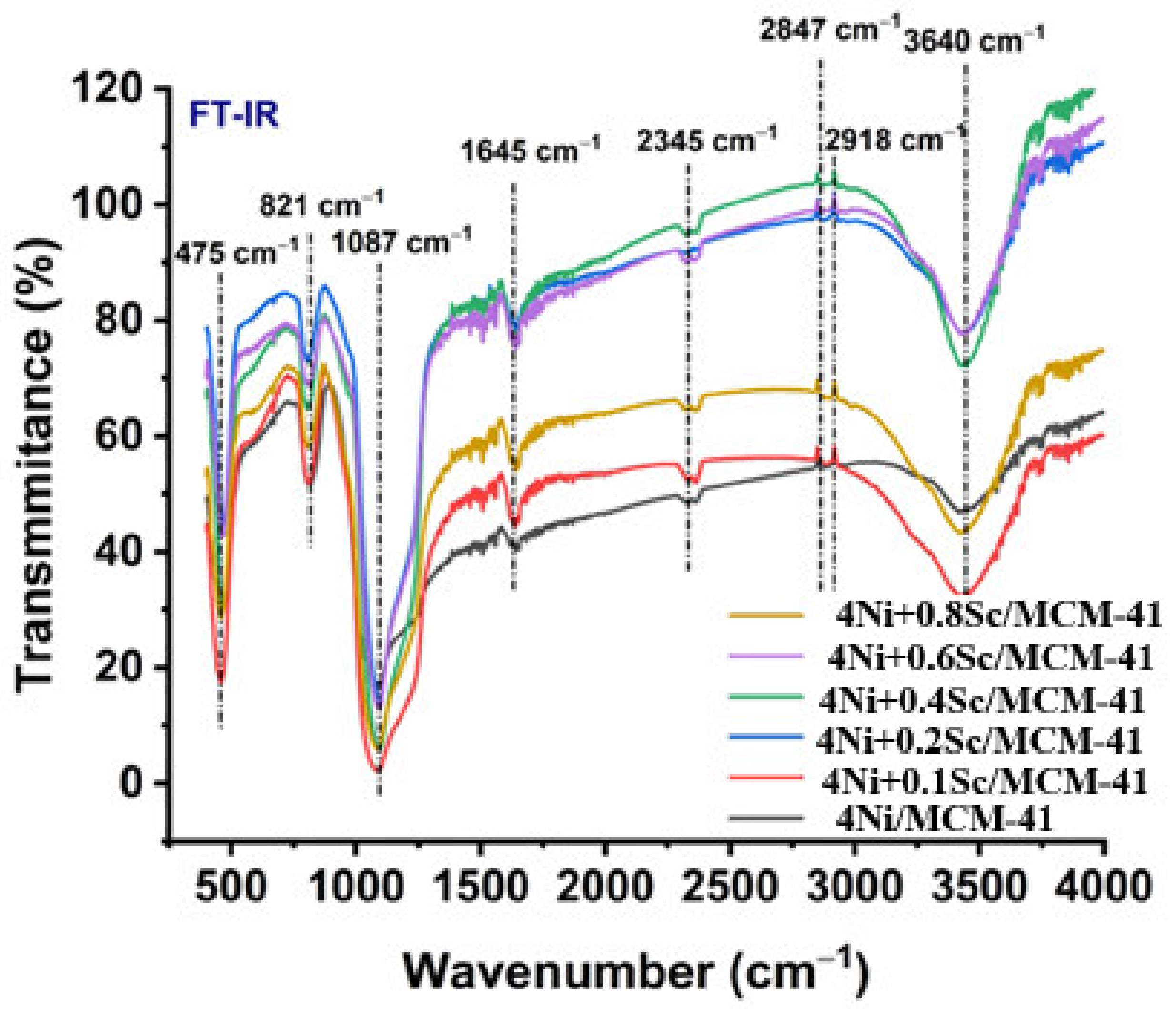
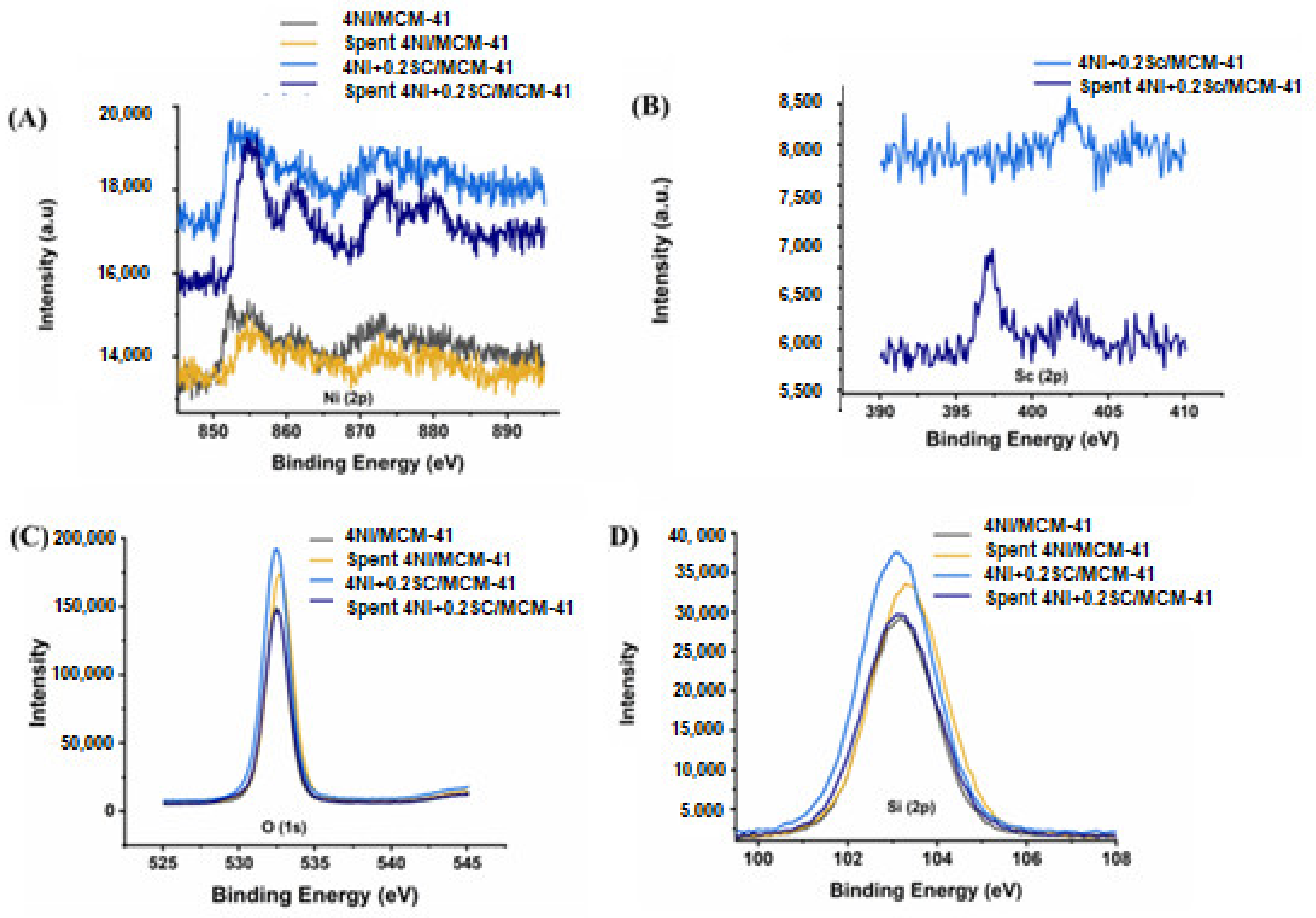
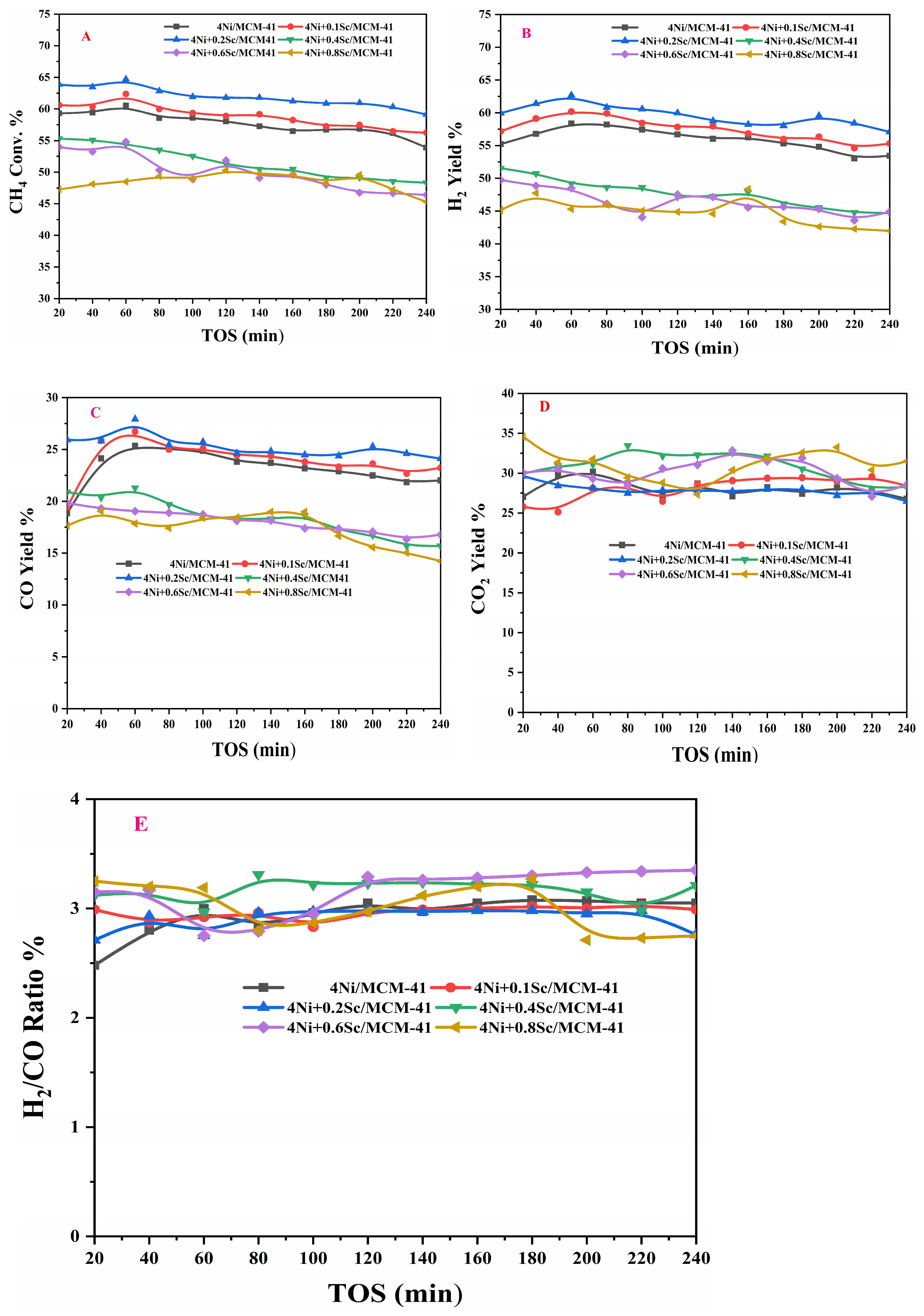
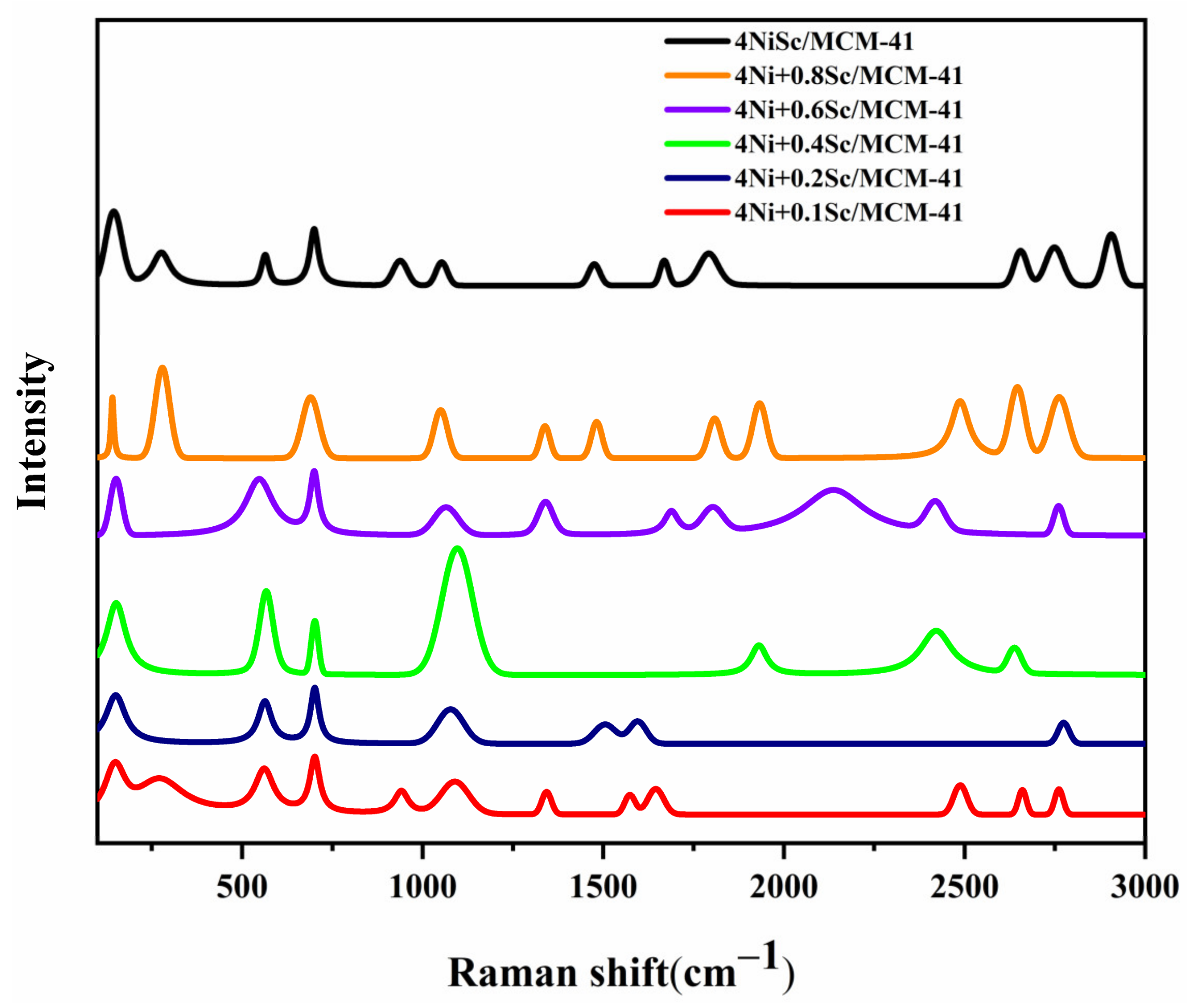


Disclaimer/Publisher’s Note: The statements, opinions and data contained in all publications are solely those of the individual author(s) and contributor(s) and not of MDPI and/or the editor(s). MDPI and/or the editor(s) disclaim responsibility for any injury to people or property resulting from any ideas, methods, instructions or products referred to in the content. |
© 2025 by the authors. Licensee MDPI, Basel, Switzerland. This article is an open access article distributed under the terms and conditions of the Creative Commons Attribution (CC BY) license (https://creativecommons.org/licenses/by/4.0/).
Share and Cite
Ibrahim, A.A.; Bellahwel, O.A.; Al-Alweet, F.M.; Amer, M.S.; Fakeeha, A.H.; Abasaeed, A.E.; Bentalib, A.S.; Al-Fatesh, A.S. Hydrogen Yield from the Partial Oxidation of Methane: Effect of Sc Promoter on Supported Ni/MCM-41 Catalyst. Catalysts 2025, 15, 337. https://doi.org/10.3390/catal15040337
Ibrahim AA, Bellahwel OA, Al-Alweet FM, Amer MS, Fakeeha AH, Abasaeed AE, Bentalib AS, Al-Fatesh AS. Hydrogen Yield from the Partial Oxidation of Methane: Effect of Sc Promoter on Supported Ni/MCM-41 Catalyst. Catalysts. 2025; 15(4):337. https://doi.org/10.3390/catal15040337
Chicago/Turabian StyleIbrahim, Ahmed A., Omer A. Bellahwel, Fayez M. Al-Alweet, Mabrook S. Amer, Anis H. Fakeeha, Ahmed E. Abasaeed, Abdulaziz S. Bentalib, and Ahmed S. Al-Fatesh. 2025. "Hydrogen Yield from the Partial Oxidation of Methane: Effect of Sc Promoter on Supported Ni/MCM-41 Catalyst" Catalysts 15, no. 4: 337. https://doi.org/10.3390/catal15040337
APA StyleIbrahim, A. A., Bellahwel, O. A., Al-Alweet, F. M., Amer, M. S., Fakeeha, A. H., Abasaeed, A. E., Bentalib, A. S., & Al-Fatesh, A. S. (2025). Hydrogen Yield from the Partial Oxidation of Methane: Effect of Sc Promoter on Supported Ni/MCM-41 Catalyst. Catalysts, 15(4), 337. https://doi.org/10.3390/catal15040337








